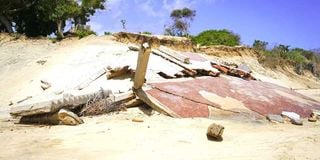Premium
Losses as ocean slowly swallows Kipini village

Some of the debris left behind after a large section of the Tana River Lodge and Hotel in Kipini village, Tana River County, was swallowed by the Indian Ocean.
What you need to know:
- The Tana River Lodge was pulled into the sea.
- The nine cottages that stood on the 10-acre piece of land where the luxurious hotel sat were all washed into the sea in 2019, and the last bits in 2020.
- All that remains is what used to be the manager’s house, standing less than 50 meters from the sea, awaiting its fate.
It is high tide and the waves are getting closer to the Indian Ocean beach near where the Tana River Lodge once stood in Kipini village.
It is here that Joseph Gachango worked as managing director 10 years ago. At the time, business was good and the resort had over 50 employees.
The hotel offered beautiful scenery, with guests able to seat in their balconies and watch fishermen race to the shores with their catch, tourists surfing the tides and dolphins entertaining visitors.
Kipini village itself was also a key attraction for tourists owing to its serene environment and beautiful dunes.
“We used to host guests from Italy, Spain and even Germany. Their second destination after Malindi was this place, which was most loved by new couples,” said Mr Gachango.
Then the sea levels rose and eroded the coastline, exposing the trees that once flanked the hotel to erosion – they fell into the sea one after the other. Now, the encroaching Indian Ocean is causing livelihood losses in Kipini as climate change accelerates in the area.
The village is experiencing an environmental tragedy as it is slowly being swallowed by the sea, with some of the most luxurious hotels and entertainment spots in the area now no more.
Located 170 kilometres from Hola, the county’s administrative headquarters, Kipini is at the mouth of the Tana Delta, where River Tana drains into the ocean.
Washed into sea
The Tana River Lodge was pulled into the sea. The nine cottages that stood on the 10-acre piece of land where the luxurious hotel sat were all washed into the sea in 2019, and the last bits in 2020.
All that remains is what used to be the manager’s house, standing less than 50 meters from the sea, awaiting its fate. Out of the ten acres the hotel stood on, four are fully submerged. The owners are holding onto the six acres hoping to make something out of them.
Mr Gachango currently doubles up as the manager and security guard of the remaining piece of land.
“It breaks my heart every day I look at this lodge and imagine the glory it held and how fast we have lost it, in less than 10 years,” said Mr Gachango.
Area residents are living in fear, walking to the shores every day to check how far the sea has moved – they do so using sticks placed on the shores.
“I am afraid, I have moved my home twice as a result of the movement of the sea in seven years; demolishing and putting up another further up. It seems I will have to move again since when I wake up, the first thing I see is the sea closing in,” said Mwanaharusi Hamadi, a resident. He is not alone.
Hundreds of other residents are also watching the sea closing in on their homes, but are lost for a way out. As the sea creeps on them, some have resolved not to put up permanent structures anymore.
Salty wells
Shallow wells that once produced fresh water have turned salty, and residents are afraid of what will happen next.
“We are afraid, we are distressed but there is nothing much we can do, this sea keeps expanding and we are certain in a few years the entire village will be underwater,” said Asha Jumaa. As the seawater continues moving towards the village, it’s making home structures weak and unsafe.
Economic activities in the village have changed and poverty levels have risen as tourism dies. In 10 years, more than 5,000 people have lost their livelihoods as the seawater floods farms.
“Lately, you cannot dig the foundation as we used to. Just a shallow dig and you start feeling the wet soil. So what we do is change how we build our structures,” said Kasim Mwamba.
Awadh Mbarak, an environmentalist, notes: “Only about 70 metres remain for the sea to take over Kipini village. April is almost here, when the sea waves rise and are very rough, that is when it claims more space.” He added that once the wind claims the dunes, all that will be left is a slope into the village, then r disaster.
Mr Mbarak proposes that to save the village from further erosion, organisations should support the planting of mangroves along the coastline.
“The mangroves will stop the sea from further movement and also form a breeding zone for fish,” he said.
However, leaders in Tana River County are pushing for a wall along the coastline and a mini-port, with the hope that it will save the village from calamity. Similar walls have been built at Fort Jesus in Mombasa, Vanga, Shimoni and Malindi after the rise in water levels threatened livelihoods near the sea.
Galole MP Said Hiribae and his Garsen counterpart Ali Wario have promised to engage various stakeholders nationally and internationally to ensure the construction of the wall starts soon.
“Kipini needs a wall just like the one that was constructed in Tanzania, though our case requires something a bit different, not just for the sake of blocking seawater intrusion, but also to drain the saline water f back to the sea,” said Mr Hiribae.
The county administration has approached the World Bank, United Nations Office for Project Services and the Global Environment Facility for funding of the wall.
Various researchers have been invited to carry out tests along the coastline to inform the type and design of the wall required for Kipini.
Tana River Governor Dhadho Godhana has proposed that the wall be built in a slanting position and incorporate viewpoints, cottages and public parks to revive tourism in the area. Further, the governor says that apart from the wall along the 76km coastline, the administration has also drawn a proposal to the World Bank for a mini-port.
“We understand there is a port in Lamu and there is space for a mini-port also in Kipini that can assist the Lamu and Mombasa ports, this port will also serve as a breaker to the erosion,” he said.
The administration also seeks to invest Sh100 million into the project to revive tourism in the area.





